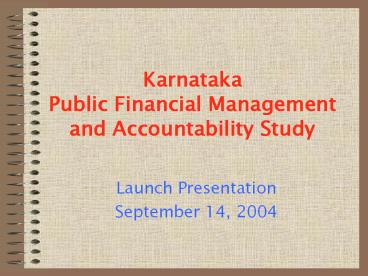Karnataka Public Financial Management and Accountability Study - PowerPoint PPT Presentation
1 / 21
Title:
Karnataka Public Financial Management and Accountability Study
Description:
Departments lack incentives, accountability and flexibility to perform. ... Increased flexibility for Departments to spend to achieve their objectives while ... – PowerPoint PPT presentation
Number of Views:191
Avg rating:3.0/5.0
Title: Karnataka Public Financial Management and Accountability Study
1
Karnataka Public Financial Management and
Accountability Study
- Launch Presentation
- September 14, 2004
2
Background and objective of report
- Examination of Karnatakas public financial
management and accountability (PFMA) system - Budget development, execution monitoring
- Accounting and financial reporting
- Internal external controls
3
Scope of report
- Core state government (Section 2)
- Other public sector entities (Section 3)
- Rural local governments
- Urban local governments
- Government companies and corporations
- Boards, Authorities and Societies
4
The financial management challenge for developing
countries.
- Developing country governments have low resources
relative to need. - Development effectiveness depends not only on
greater revenue mobilization but also increased
spending efficiency ensuring that spending
achieves the governments purposes. - That is the focus of this report
5
A. STATE GOVERNMENT
6
Karnataka has the foundations of a satisfactory
PFMA system
- Well-established, sound legal framework for PFMA
in place. - Robust fiscal policy framework
- Annual budget provides tight controls over most
areas of spending. - Annual accounts prepared annually, and in timely
manner monthly accounts also used. - Independent external auditor regular, timely and
useful audits - Well-established framework for legislative review.
7
but faces significant challenges
- Budgets cannot be fully implemented on average,
revenues only 91 of budgeted level for last 8
years. - Departments lack incentives, accountability and
flexibility to perform. - Off-budget borrowing circumvents budgetary
controls. - Weaknesses in accounting e.g. Public Accounts.
- Internal control weaknesses capital projects,
power subsidy no commitment controls
8
Significant challenges (cont.)
- Audit and legislative review processes need to be
more effectively used. - Greater fiscal transparency will generated
demands for financial performance.
9
Though much remains to be done, reforms are
underway
- Fiscal reform showing results
- Budget being shifted towards departmental focus.
- Office of Controller (Accounts Management) has
been created. - Computerized, networked treasury system is now
operational. - More fiscal information in the public domain.
- Responsiveness to audit reports has improved.
10
Nine priorities moving forward
- Strengthening budgetary control and
effectiveness. - Preparing more realistic budgets
- Reducing reliance on supplementary budgets
- Eliminating off-budget borrowing
11
Priority 2 Shift to Departmental budgeting
- To provide departments with greater flexibility
and incentives to perform - Organize the budget around Demands for Grants
(departments) - All Departments to complete Departmental MTFPs,
with performance targets, and should report
against these targets - Increased flexibility for Departments to spend to
achieve their objectives while keeping pressure
on to reduce administrative costs. - Shift to program budgeting
12
Priority 3 Improving accounting
- Completing the computerization agenda
- Improving Public Account accounting
- Ensuring regularity in basic accounting
procedures controls - Improving GoK-CAG collaboration on accounting.
13
Priority 4 Strengthening internal controls
- Greater controls over capital projects
- Introduce controls over commitments
- The open-ended power subsidy obligation is the
biggest threat to the budget, and needs to be
brought under control through implementation of
the purchaser-provider model. - Introduction of internal audit function in
expenditure departments. - Modernization of rule books
14
Other priorities
- 5. Sustain and expand recent efforts to improve
audit responsiveness - 6. Improving information disclosure and
accessibility - 7. Strengthening capacity for financial
management. - 8. Accelerating procurement reforms.
- 9. Improve fund-flow predictability
15
B. OTHER PUBLIC SECTOR ENTITIES
16
Outside the State Government, PFMA systems are
less robust
- These entities are important there are large
numbers of them and they handle significant
volume of funds - Weaknesses are especially evident in rural and
urban local governments, and Boards and
Authorities. - PFMA system in government companies and
corporations performing relatively better.
17
Major priorities for these other government
entities
- Improving compliance with core PFMA priorities
timely and regular accounts, audits, follow-up on
audits and legislative reports, and transparency.
- Strengthening governance of public sector
entities by creating a Public Enterprises
Selection Board for all senior appointments. - Putting strengthening of financial management at
the center of on-going efforts to strengthen
rural and urban local governments. - Improving the PFMA legal and institutional
framework for some entities.
18
CONCLUSION
19
Not all reforms can be done at the state level
- Abolishing the Plan/Non-Plan distinction.
- Introducing satisfactory accounting and financial
reporting standards, and modernizing accounting. - Modernizing audit.
- Improvements in legislative review processes.
20
But a lot can be
- The impression should not be created that there
is nothing the states can do to improve financial
management. To the contrary, the states have
sufficient autonomy and responsibility to
substantially transform their own financial
management environment. - Karnataka is in a good position to take a
leadership role on the PFMA agenda in India. The
state is fortunate to have a strong bureaucracy,
a reforming political leadership, and a demanding
civil society. It has already taken important
actions to improve public financial management
and accountability. Continued progress will
pay rich dividends for Karnataka by making
government more effective, accountable and
responsive.
21
3 priority reform areas
- Strengthen the budget budget realistically and
restrict new initiatives to the budget. - Rebalance financial controls microcontrols can
be relaxed, but greater controls are needed over
power subsidy obligations and capital projects - Fully implement the states accounting and
auditing framework.































